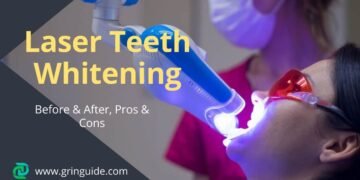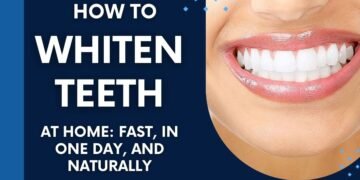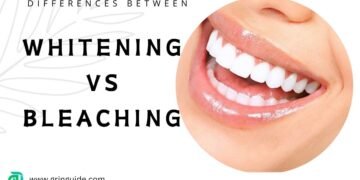Table of Contents
Introduction
Teeth whitening has become an increasingly popular aspect of oral care, driven by the universal desire for a brighter, more confident smile. The process of teeth whitening involves various techniques and products designed to lighten the color of teeth and eliminate stains. This cosmetic dental procedure has gained immense popularity over the years, as a radiant smile is often associated with health, confidence, and social success.
Historically, the pursuit of whiter teeth dates back to ancient civilizations. The Egyptians, for instance, used a mixture of ground pumice stone and wine vinegar to achieve a brighter smile. Similarly, the Romans employed urine and goat milk as whitening agents. Despite the unconventional methods, the underlying desire for aesthetically pleasing teeth has remained consistent throughout history.
In modern times, the approach to teeth whitening has evolved significantly, with advancements in dental technology and the availability of over-the-counter products making it more accessible and effective. Today, individuals can choose from a variety of teeth whitening options, including professional treatments conducted by dentists and at-home kits that offer convenience and affordability. The contemporary methods promise not only enhanced aesthetics but also a safer experience compared to historical practices.
The continued significance of teeth whitening in today’s society can be attributed to the impact it has on an individual’s self-esteem and overall appearance. A bright smile can enhance one’s attractiveness, making it a sought-after trait. Consequently, teeth whitening has become an integral part of many people’s oral care routines, reflecting a broader trend towards personal grooming and wellness.
As we delve deeper into the various aspects of teeth whitening in this guide, we will explore the different methods available, their effectiveness, and the factors to consider when choosing the best option for your needs. Whether you’re looking to improve your smile for a special occasion or simply want to boost your everyday confidence, understanding the fundamentals of teeth whitening is the first step towards achieving your goals.
Causes of Teeth Discoloration
Teeth discoloration is a common concern that can significantly impact one’s smile and confidence. Various factors contribute to this condition, categorized mainly into dietary habits, lifestyle choices, aging, and medications.
1. Dietary habits
Dietary habits play a crucial role in teeth discoloration. Consuming beverages like coffee, tea, and red wine can lead to the accumulation of stains on the tooth surface.
These drinks contain chromogens, which are deeply pigmented molecules that attach to the enamel, resulting in extrinsic stains. Similarly, foods with high acidity, such as citrus fruits, can erode enamel and make teeth more susceptible to discoloration.
2. Smoking
Smoking and the use of tobacco products are among the leading causes of teeth staining. The nicotine and tar in tobacco can create stubborn yellow or brown stains on the teeth, which are often challenging to remove through regular brushing alone.
These substances also contribute to the buildup of plaque and tartar, exacerbating the discoloration.
3. Aging
Aging is another significant factor in teeth discoloration. Over time, the enamel, which is the outer layer of the teeth, wears down, revealing the underlying dentin. Dentin is naturally yellowish, and as the enamel becomes thinner with age, the teeth appear more yellow. This type of discoloration is known as intrinsic staining.
4. Medications
Certain medications can also lead to teeth discoloration. For instance, antibiotics like tetracycline and doxycycline can cause intrinsic stains, particularly in children whose teeth are still developing. Additionally, antihistamines, antipsychotic drugs, and medications for high blood pressure can also contribute to the darkening of teeth.
There are two main types of tooth stains: Extrinsic and Intrinsic
- Extrinsic stains: are surface-level discolorations caused by external factors such as coffee, tea, red wine, and smoking.
- Intrinsic stains: on the other hand, occur within the tooth structure and can be due to aging, genetics, medications, or trauma to the teeth.
Effective teeth whitening methods can address both types of stains, but the approach may vary depending on the underlying cause.
Professional Teeth Whitening Options
Achieving a brighter smile often starts with professional teeth whitening treatments. These procedures are carried out by dental professionals and offer more significant, immediate results compared to over-the-counter products. Among the most prevalent methods are in-office bleaching and custom-fitted whitening trays.

1. In-office bleaching (Laser whitening)
In-office bleaching is one of the most popular professional teeth whitening treatments. During this procedure, a high-concentration bleaching gel is applied to the teeth by a dentist, followed by the use of a laser to activate the whitening agents. The laser accelerates the chemical reaction, leading to quicker and more dramatic results.
This method typically takes about an hour and can produce results that are up to eight shades whiter.
One of the primary benefits of in-office bleaching is the rapid transformation, often visible after just one session. However, some individuals may experience temporary tooth sensitivity or gum irritation as side effects.
The cost for in-office bleaching can range from $500 to $1,000 per session, depending on the dental clinic’s location and reputation.
2. Custom-fitted whitening trays
Custom-fitted whitening trays offer a more personalized approach to teeth whitening. In this method, a dentist creates custom molds of the patient’s teeth to fabricate trays that fit perfectly. These trays are then used at home with a professional-grade bleaching gel.
This method allows for gradual whitening over several weeks, giving patients control over the process. Custom-fitted trays minimize the risk of gum irritation, but some users may still experience sensitivity. The cost for this treatment typically falls between $300 and $600.
Each professional teeth whitening option has its unique benefits and potential side effects. While in-office bleaching and laser whitening provide quick, dramatic results, custom-fitted trays offer a more controlled, gradual approach.
Ultimately, the choice depends on individual needs, budget, and dental health considerations.
Over-the-Counter Whitening Products
Over-the-counter teeth whitening products have gained significant popularity due to their accessibility and affordability. These products come in various forms, including whitening strips, toothpaste, gels, and rinses. Each type offers different degrees of effectiveness, ease of use, and potential risks or limitations that users should consider.
Whitening strips are one of the most commonly used over-the-counter products. These thin, flexible strips are coated with a peroxide-based whitening gel and are applied directly to the teeth. They are generally easy to use and can produce noticeable results within a few weeks. However, the effectiveness of whitening strips can vary, and they may cause sensitivity in some users.
Whitening toothpaste is another popular option. These toothpastes contain mild abrasives and chemical agents designed to remove surface stains. While they can help maintain a brighter smile, their whitening capabilities are limited compared to other products. They are best used as a supplement to other whitening methods rather than a standalone solution.
Whitening gels are typically applied using a small brush directly onto the teeth. These gels often contain higher concentrations of peroxide than strips and toothpaste, which can result in more dramatic whitening effects. However, they may also increase the risk of tooth sensitivity and gum irritation. It is important to follow the manufacturer’s instructions carefully to minimize potential side effects.
Lastly, whitening rinses are mouthwashes that contain whitening agents. They are easy to incorporate into a daily oral hygiene routine and can help to reduce surface stains. However, their effectiveness is generally less pronounced compared to other over-the-counter options. They are best used as a maintenance product rather than a primary whitening treatment.
Overall, over-the-counter teeth whitening products offer a range of options for achieving a brighter smile. While they are generally safe when used as directed, it is essential to be aware of potential risks and limitations. Consulting with a dental professional can provide additional guidance and ensure the best results for individual needs.
Natural Teeth Whitening Remedies
In the quest for achieving a brighter smile, many individuals turn to natural teeth whitening remedies. These DIY methods, including the use of baking soda, hydrogen peroxide, and activated charcoal, have garnered considerable attention. However, it is crucial to understand the efficacy and safety of these approaches before incorporating them into your oral care routine.
Baking soda is a common household item frequently cited for its teeth whitening properties. It functions as a mild abrasive, helping to scrub away surface stains on the teeth. Some studies suggest that toothpaste containing baking soda is more effective at removing stains than standard toothpaste. However, it is essential to use it sparingly, as excessive use can erode tooth enamel.
Hydrogen peroxide is another popular natural remedy. It acts as a bleaching agent, breaking down the molecules that cause discoloration. Over-the-counter whitening products often contain low concentrations of hydrogen peroxide, which are considered safe for use. Nonetheless, high concentrations or prolonged use can lead to gum irritation and tooth sensitivity.
Activated charcoal has gained popularity in recent years as a tooth whitening agent. The porous nature of activated charcoal purportedly allows it to bind to and remove stains from the teeth. However, scientific evidence supporting its efficacy is limited. Additionally, its abrasive texture poses a risk of enamel erosion, potentially causing more harm than good.
While these natural remedies offer potential benefits, it is imperative to approach them with caution. Overuse or improper application can lead to adverse effects, such as enamel damage or increased tooth sensitivity. Consulting with a dental professional before trying any natural teeth whitening methods is advisable to ensure safe and effective use.
How to choose best teeth whitening methods
When it comes to teeth whitening, the choice between do-it-yourself (DIY) methods and professional treatments is an important decision. Let’s explore the pros and cons of each approach to help you decide which method aligns with your needs and lifestyle.
1. DIY Teeth Whitening: An Affordable Route
Pros:
- Affordable: DIY teeth whitening kits, such as strips or gels, are budget-friendly compared to professional treatments.
- Convenient: You can whiten your teeth at home on your own schedule.
- Low Risk of Sensitivity: If you follow instructions carefully, the risk of tooth sensitivity is minimal.
Cons:
- Limited Results: DIY methods generally achieve modest whitening (around 2-4 shades), whereas professional treatments can whiten significantly (8-10 shades or more).
- Surface Stains Only: DIY options primarily address surface stains and may not treat deeper intrinsic stains.
- Multiple Treatments Required: Achieving results may take several weeks of consistent use.
2. Professional Teeth Whitening: The Power of Expert Care
Pros:
- Dramatic Results: Professional treatments can whiten teeth by 8-10 shades or more in just one or two visits.
- Deeper Cleaning Power: They target both surface and intrinsic stains.
- Customized Treatment: Dentists tailor the whitening process to your individual needs.
- Safety and Supervision: Dentists ensure safety and address any sensitivity concerns.
Cons:
- Higher Cost: Professional whitening is pricier than DIY options.
- Office Visit Required: You’ll need to visit the dental office for in-office treatments.
Weighing Your Options
- DIY: Affordable, convenient, but limited results.
- Professional: good results, customized treatment, but higher cost.
Briefly, the choice depends on your preferences, budget, and desired level of whitening. Remember that both methods can brighten your smile, but they significantly differ in terms of effectiveness, safety, speed, and longevity of results.
Maintaining Your Whitened Smile

After investing time and resources into teeth whitening, it is crucial to adopt a regimen that maintains the brightness of your smile. Consistent and mindful practices can significantly prolong the effects of your whitening treatment. Here are some practical tips to help you sustain that radiant smile.
Firstly, your dietary choices play a substantial role in maintaining whitened teeth. Foods and beverages that are high in chromogens, tannins, and acids can stain your teeth. To preserve your teeth’s whiteness, try to limit the intake of coffee, tea, red wine, and dark-colored berries. When you do consume these, consider using a straw to minimize contact with your teeth, and rinse your mouth with water afterwards to reduce staining potential.
Secondly, maintaining exemplary oral hygiene practices is paramount. Brush your teeth at least twice a day using a fluoride toothpaste, and ensure you are doing so for at least two minutes each time. Incorporating whitening toothpastes can be beneficial in preventing new stains. Flossing daily is equally important, as it removes plaque and food particles that can discolor your teeth. Additionally, using an antiseptic mouthwash can help maintain oral health and cleanliness.
Regular dental check-ups are another crucial aspect of keeping your teeth white. During these visits, professional cleanings can remove plaque and tartar buildup that regular brushing and flossing might miss. Your dentist can also provide touch-up whitening treatments if necessary, ensuring that your smile remains as bright as possible.
Lastly, consider avoiding habits that can discolor teeth, such as smoking. Tobacco products are notorious for causing yellow stains and can quickly diminish the effects of teeth whitening treatments.
By integrating these dietary adjustments, oral hygiene practices, and routine dental appointments into your lifestyle, you can effectively maintain the bright, white smile achieved through teeth whitening treatments.
Potential Risks and Side Effects
Teeth whitening has surged in popularity as individuals seek brighter smiles, but it is not without its potential drawbacks.
One common side effect is tooth sensitivity. This occurs when the whitening agents, often hydrogen peroxide or carbamide peroxide, penetrate the enamel and reach the dentin layer, which houses the nerves. This can lead to temporary discomfort when consuming hot or cold foods and beverages. To mitigate this, it is advisable to use desensitizing toothpaste and avoid extremely hot or cold foods immediately after the whitening procedure.
Another potential issue is gum irritation. This happens when the whitening gel comes into contact with the soft tissues of the mouth. Symptoms can include redness, swelling, and even bleeding in severe cases. To minimize this risk, it is crucial to apply the whitening gel carefully, ensuring it stays on the teeth and does not spread to the gums. Custom-fitted whitening trays, often provided by dental professionals, can help achieve more precise application compared to over-the-counter products.
Enamel damage is also a concern with teeth whitening. Overuse of whitening products can erode the enamel, the outermost layer of the teeth, making them more susceptible to decay and cavities. To avoid this, it is important to follow the manufacturer’s guidelines and not exceed the recommended usage frequency. Consulting with a dental professional before starting any whitening regimen can provide personalized advice and help determine the most suitable and safe options.
In some cases, individuals may experience uneven whitening or white spots on the teeth. This usually occurs due to pre-existing dental conditions such as decalcification or the presence of fillings and crowns that do not respond to whitening agents. Seeking professional advice can help identify these issues beforehand and ensure a more uniform whitening result.
Overall, while teeth whitening can offer significant aesthetic benefits, it is essential to be aware of its potential risks and side effects. Proper application techniques, adherence to guidelines, and consultation with dental professionals can help mitigate these risks and achieve a brighter, healthier smile safely.
Is Teeth Whitening Right for You?
Deciding whether teeth whitening is the right choice for you involves careful consideration of various factors, including your dental health, personal goals, and the availability of alternative cosmetic dental procedures. Teeth whitening can significantly enhance your smile, but it’s essential to ensure that it aligns with your overall dental health and aesthetic objectives.
First, evaluate your dental health. Teeth whitening is generally safe, but it may not be suitable for everyone. Individuals with sensitive teeth, gum disease, or worn enamel should consult with a dental professional before undergoing any whitening treatments. Your dentist can assess your oral health and recommend the best approach, ensuring that the procedure does not exacerbate any existing issues.
Next, consider your personal goals. Teeth whitening can address discoloration caused by factors such as aging, coffee, tea, or tobacco use. If your primary goal is to achieve a brighter smile and boost your confidence, teeth whitening can be an effective solution. However, it’s important to have realistic expectations. The results can vary based on the initial shade of your teeth and the type of whitening method used. Discussing your goals with a dental professional can help you understand what to expect and whether teeth whitening will meet your needs.
Lastly, explore alternative cosmetic dental procedures. While teeth whitening is popular, other options may better suit your needs. For instance, dental veneers or bonding might be more appropriate if you have significant tooth damage or discoloration that whitening cannot address. These procedures can provide a more comprehensive solution to enhance your smile. Consulting with a cosmetic dentist can help you weigh the pros and cons of each option and determine the best course of action for your unique situation.
By carefully considering your dental health, personal goals, and alternative treatments, you can make an informed decision about whether teeth whitening is the right choice for you.
Conclusion and Final Thoughts
Throughout this comprehensive guide on teeth whitening, we have explored various methods to achieve a brighter smile, ranging from professional treatments to at-home solutions. It’s evident that while teeth whitening can dramatically enhance one’s appearance and boost self-confidence, it is essential to approach the process with caution and informed decision-making.
We delved into professional teeth whitening options, highlighting their effectiveness and safety when performed under the supervision of a dental professional. These methods, including in-office bleaching and custom-fit trays, tend to yield faster and more reliable results compared to over-the-counter products. However, they also come at a higher cost and may not be suitable for everyone.
On the other hand, at-home teeth whitening alternatives, such as whitening strips, gels, and toothpastes, offer a more accessible and affordable approach. While these products can be effective in removing surface stains, their results may vary, and it is crucial to follow the instructions meticulously to avoid adverse effects like tooth sensitivity or gum irritation.
We also touched upon natural remedies and lifestyle changes that can support and maintain a whiter smile. Simple practices such as regular brushing and flossing, reducing the intake of staining foods and beverages, and avoiding tobacco products can significantly contribute to the longevity of teeth whitening results.
Ultimately, the importance of consulting with a dental professional before embarking on any teeth whitening regimen cannot be overstated. A dentist can provide personalized advice based on an individual’s oral health condition, ensuring that the chosen method is both safe and effective. Additionally, routine dental check-ups are essential to monitor the health of your teeth and gums, preventing potential complications.
Making informed decisions regarding teeth whitening is a vital aspect of maintaining overall oral health. By understanding the various options and taking professional guidance into account, individuals can achieve and sustain a brighter, healthier smile with confidence.
FAQs
we will address some frequently asked questions (FAQs) about teeth whitening to help you navigate the often-overwhelming world of dental care.
-
How Does Teeth Whitening Work?
Teeth whitening treatments generally utilize bleaching agents to remove stains and discoloration.
These agents, such as carbamide peroxide or hydrogen peroxide, lighten the color of teeth by penetrating deep into the enamel and breaking down pigments. -
Is Teeth Whitening Safe?
When performed correctly, teeth whitening is safe.
It’s essential to follow product instructions or professional advice to avoid damaging your enamel. -
Does Teeth Whitening Cause Sensitivity?
Some people may experience temporary sensitivity during or after teeth whitening treatments.
Using products designed for sensitive teeth can help alleviate this discomfort. -
How Long Does Teeth Whitening Last?
The effects of teeth whitening can last from a few months to up to three years, but this varies from person to person.
Avoiding staining foods and drinks can prolong the results. -
Can I Whiten Crowns or Fillings?
Whitening treatments do not affect the color of crowns, fillings, or veneers. They only work on natural teeth.
-
Are Over-the-Counter Products Effective?
Over-the-counter whitening products can be effective, but they are generally not as potent as professional treatments.
Always look for products with an ADA Seal of Acceptance. -
How Many Shades Can I Expect to Whiten?
Results can vary widely, but many people can achieve a change of two to seven shades.
Professional treatments typically offer more significant results. -
Does Teeth Whitening Hurt?
Teeth whitening should not hurt. If you experience pain, you should stop using the product and consult a dentist.
SOURCES:









